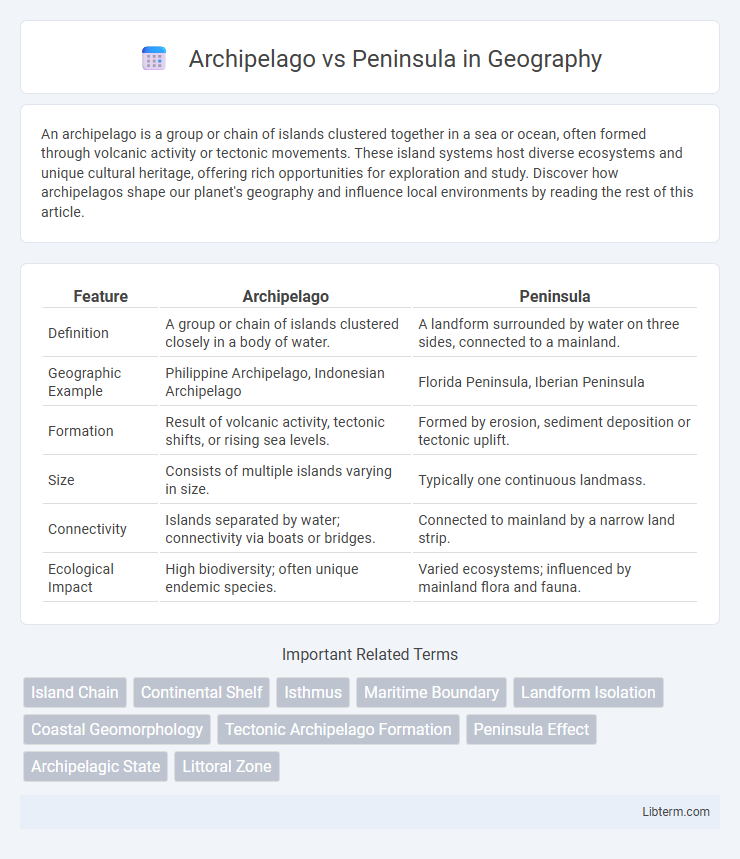An archipelago is a group or chain of islands clustered together in a sea or ocean, often formed through volcanic activity or tectonic movements. These island systems host diverse ecosystems and unique cultural heritage, offering rich opportunities for exploration and study. Discover how archipelagos shape our planet's geography and influence local environments by reading the rest of this article.
Table of Comparison
| Feature | Archipelago | Peninsula |
|---|---|---|
| Definition | A group or chain of islands clustered closely in a body of water. | A landform surrounded by water on three sides, connected to a mainland. |
| Geographic Example | Philippine Archipelago, Indonesian Archipelago | Florida Peninsula, Iberian Peninsula |
| Formation | Result of volcanic activity, tectonic shifts, or rising sea levels. | Formed by erosion, sediment deposition or tectonic uplift. |
| Size | Consists of multiple islands varying in size. | Typically one continuous landmass. |
| Connectivity | Islands separated by water; connectivity via boats or bridges. | Connected to mainland by a narrow land strip. |
| Ecological Impact | High biodiversity; often unique endemic species. | Varied ecosystems; influenced by mainland flora and fauna. |
Introduction to Archipelagos and Peninsulas
Archipelagos are groups or chains of islands scattered closely in a body of water, often formed by volcanic activity or rising sea levels, whereas peninsulas are landforms surrounded by water on three sides while connected to a mainland. Archipelagos like the Indonesian or Philippine archipelago consist of hundreds to thousands of individual islands, creating unique ecosystems and diverse habitats. In contrast, peninsulas such as the Iberian or Florida Peninsula extend landmasses into oceans or seas, serving as crucial geographic links between bodies of water and continental territories.
Defining Archipelago: Characteristics and Formation
An archipelago is a collection of islands closely grouped in a body of water, characterized by its fragmented landmasses often formed through volcanic activity, tectonic movements, or rising sea levels submerging parts of a landmass. Unlike a peninsula which is a connected land extending into a water body, archipelagos consist of numerous individual landforms, each surrounded by water. Famous examples include the Indonesian Archipelago formed largely by tectonic plate boundaries and volcanic activity, highlighting their dynamic geological origins.
Understanding Peninsulas: Features and Types
Peninsulas are landforms surrounded by water on three sides, characterized by their connection to a mainland, influencing coastal ecosystems and human settlement patterns. Common types include tombolos, where a peninsula connects to an island via a sandbar, and coastal peninsulas shaped by tectonic activity or land erosion. Understanding peninsula features enhances knowledge of geographical diversity, marine biodiversity, and strategic importance in transportation and defense.
Key Geographical Differences
An archipelago consists of a group or chain of islands clustered closely together in a body of water, typically formed by volcanic activity or rising sea levels. A peninsula is a landform surrounded by water on three sides but still connected to a mainland, often shaped by tectonic movements or coastal erosion. Key geographical differences include the fact that archipelagos are multiple isolated landmasses while peninsulas are single continuous land extending out from a continent.
Climate Variations in Archipelagos vs. Peninsulas
Archipelagos experience more localized climate variations due to the surrounding ocean's influence, resulting in milder temperatures and higher humidity compared to peninsulas. Peninsulas often display greater climate gradients with pronounced continental effects on the landward side, leading to more distinct seasonal changes. The oceanic buffer in archipelagos moderates extremes, while peninsulas face diverse microclimates shaped by their larger land connections.
Biodiversity and Ecosystem Comparisons
Archipelagos typically support higher biodiversity than peninsulas due to their isolated islands fostering unique species evolution and endemism. Peninsulas, connected to larger landmasses, often experience greater species migration, resulting in more homogeneous ecosystems but less endemism. The fragmented habitats in archipelagos create diverse microenvironments, enhancing ecosystem complexity compared to the more continuous ecosystems of peninsulas.
Human Settlements and Cultural Impact
Archipelagos foster diverse cultural interactions and maritime economies due to their dispersed islands, encouraging unique settlement patterns centered around fishing, trade, and navigation. In contrast, peninsulas often support contiguous, dense human settlements with easier land-based transportation and agriculture, facilitating cohesive cultural development and political integration. Both landforms influence distinct social structures, with archipelagos promoting insular communities and peninsulas enabling regional connectivity and cultural exchange.
Economic Activities: Tourism, Fishing, and Trade
Archipelagos often thrive on fishing due to abundant surrounding waters, supporting local economies with seafood exports and artisanal fisheries. Tourism flourishes in archipelagos thanks to pristine beaches, diverse marine life, and island-hopping opportunities that attract international visitors. Peninsulas benefit from strategic locations for trade and transportation, leveraging extensive coastlines and port facilities, while tourism and fishing also play significant roles in their mixed economic activities.
Famous Examples Worldwide
Famous archipelagos include the Indonesian Archipelago, comprising over 17,000 islands, and the Hawaiian Islands, known for their volcanic origins and diverse ecosystems. Notable peninsulas such as the Iberian Peninsula, home to Spain and Portugal, and the Arabian Peninsula, the largest in the world, are significant for their strategic geopolitical and cultural importance. Each landform shapes regional climate, biodiversity, and human settlement patterns uniquely.
Conclusion: Choosing Between Archipelago and Peninsula
Selecting between an archipelago and a peninsula depends on geographical context, ecological diversity, and economic activities such as tourism and fishing. Archipelagos offer unique biodiversity and opportunities for island-hopping adventures, while peninsulas provide extensive coastlines connected to larger landmasses, supporting agriculture and trade. Understanding these factors helps determine the ideal choice based on environmental stability and human use.
Archipelago Infographic

 libterm.com
libterm.com